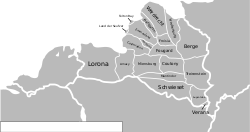Werdrecht
| High County of Werdrecht Hoge Graafschap van Werdrecht
|
||||||
|---|---|---|---|---|---|---|
|
||||||
| Capital | Wardrecht | |||||
| Official languages | Wernacht (Batavian) | |||||
| Religion | Christian | |||||
| Demonym | Werdrecht, | |||||
| State of | ||||||
| Government | Parliamentary Constitutional Monarchy | |||||
| - | High Count | Lubijik | ||||
| - | First Councilman | Gregor Kelhaver | ||||
| Legislature | Werdrecht National Council | |||||
| - | Upper house | House of Governors | ||||
| - | Lower house | House of Men | ||||
| Autonomous State | ||||||
| Population | ||||||
| - | estimate | 3,400,000 | ||||
| - | 2010 census | 3,778,844 | ||||
| Currency | Thauler, (Formerly: Guild) | |||||
| Internet TLD | .wd | |||||
Werdrecht, the most northerly state of Bergenstein. It's culture is highly similar to that of Batavia along with sharing the same language. However Batavian in Werdrecht is often and officially called Wernacht. The state is one of the larger Bergentsein states with a prominent quantity of power within Bergenstein. Werdrecht has in the past had a successful history making Werdrecht slightly richer than other parts of Bergenstein.
Provinces
Werdrecht is partitioned into provinces that are in control of local facilities and services. Each is headed by a governor who also sits on the House of Governors. List:
- Orechte
- Drechte
- Vaatred
- Limgarn
- Bragentein
Culture
Cuisine
Traditionally, Werdrecht cuisine is simple and straightforward, with many vegetables and meat; breakfast and lunch are typically bread with toppings while dinner is meat and potatoes, supplemented with seasonal vegetables. The Werdrecht diet is relatively high in carbohydrates and fat, reflecting the dietary need of the laborers whose culture molded the state in years gone by. The food normally contains many dairy products, without many refinements. It is best described as rustic, though many holidays are still celebrated with special foods.
In Werdrecht many different food stuff are found, due to the high consumption of dairy products, cheese making has flourished in the area. Some famous types are Gouda and Edam. Butter is also produced on a large scale. Here aew some well know dishes:
- Hutspot, made with potatoes, carrots, and onions served with meats like rookworst (smoked sausage), slow-cooked meat, or bacon. Before potatoes were introduced in Althenia hutspot was made from parsnips, carrots, and onions
- Andijviestamppot, raw endive mashed with hot potatoes, served with diced fried spek (a kind of bacon)
- Hete bliksem (literally Hot Lightning), boiled potatoes and green apples, served with stroop (treacle) or tossed with diced speck
- Zuurkoolstamppot, sauerkraut mashed with potatoes. Served with fried bacon or a sausage.
- Boerenkoolstamppot, curly kale mixed with potatoes, served with gravy, mustard, and rookworst sausage. It is one of the oldest and most popular Werdrecht dishes. Boerenkool was mentioned in cookbooks from the year 1661. 1661 mashed potatoes were not used in this dish yet, although the sausage was already served with the cabbage in this dish. The dish became popular after a few bad corn-seasons when potatoes became popular as food. Boerenkool is high in carbohydrates, which makes it a popular meal for cold winter days
- Snert is a very thick pea soup that can be served either as a main dish or as an appetizer and is traditionally eaten during the winter. Snert has a very thick consistency and often includes pieces of pork and rookworst and is almost a stew rather than a soup. The thick consistency of the Dutch pea soup is often described as that "...you should be able to stand a spoon upright in a good pea soup".[5] It is customarily served with roggebrood (rye bread) spread with butter and topped with katenspek, a variety of bacon which is first cooked and then smoked. The meat from the soup may also be put on the rye bread and eaten with mustard.

